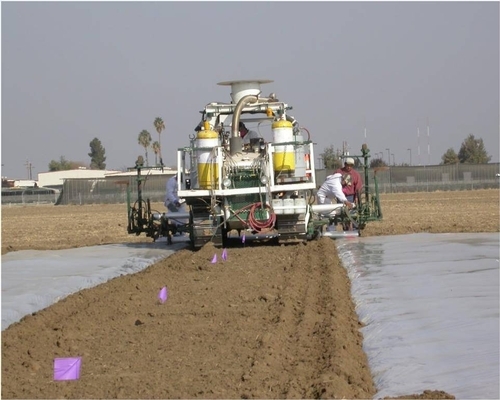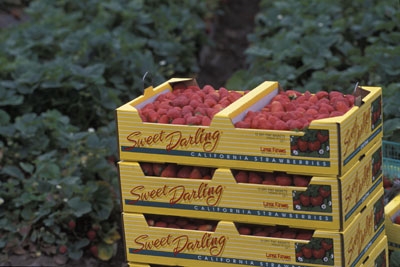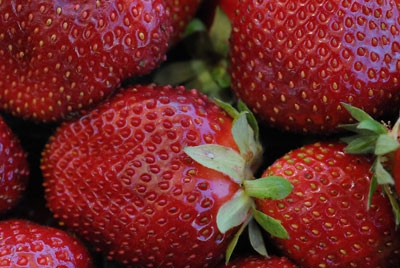
Posts Tagged: methyl iodide
Methyl iodide applied on a Sanger farm
Even as controversy continues to swirl about the use of methyl iodide in agriculture, the fumigant was used for the first time in California when it was applied to a one-acre Sanger chile pepper farm this month, the Fresno Bee reported.
The story, written by Robert Rodriguez, said the farm, northwest of DeWolf and North avenues, is owned by Sarkis Sarabian.
The California Department of Pesticide Regulation approved the use of methyl iodide in December and created restrictions that include buffer zones, special training and tarps to contain the chemical.
"These are the strictest conditions in the nation," Fresno agricultural commissioner Carol Hafner was quoted in the story. "And we made sure they were followed. Everything went fine."
The article generated numerous outraged comments.
"Our government is now in the business of feeding poison to people and telling us that it's good for us," said one.
"It's the biggest disgrace of our time. Killing a nation as well as the rest of the world with this garbage. Feeding people empty foods with little nutritional value. Nice to fatten your wallet while the world withers to dust," wrote another.
UC Riverside emeritus professor Jim Sims also posted a comment on the Fresno Bee website, pointing readers to a DPR document that explains DPR's decision to register methyl iodide. Sims is the patent-holder for methyl iodide as a soil fumigant. He spent more than 30 years researching the chemical in the lab and in the field.
Sims recently penned the "pro" view of a "point/counter point" op-ed piece about methyl iodide for The Salinas Californian.
He said that:
- Methyl iodide doesn't make the cancer-causing-chemical lists of the world's leading agencies for cancer research.
- Methyl iodide is a naturally occurring compound present in the sea and air and on land.
- Research demonstrates that methyl iodide does not get into groundwater supplies.
- Methyl iodide has been used on thousands of acres in the United States without a single negative impact to human health or the environment.
The "con" view was written by Pesticide Watch Education Fund director Paul S. Towers.
He said that:
- Methyl iodide is so reliably carcinogenic that it is used in the lab to create cancer cells.
- Washington state denied the use of methyl iodide based on California's scientific review.

For more on methyl iodide, see Hanson's December 2010 blog post.
Lawsuit filed to block usage of methyl iodide
Environmental and farmworker groups announced yesterday they have filed a lawsuit challenging the state Department of Pesticide Regulation's decision to register methyl iodide as an agricultural pesticide, according to reports in all of California's major media outlets.
The plaintiffs also appealed to newly inaugurated California Governor Jerry Brown to reverse DPR's decision, calling it "irresponsible and illegal."
Earthjustice and the California Rural Legal Assistance Inc. believe state pesticide regulators improperly cut off public comment on the chemical's approval, didn't listen to their own scientists and failed to use good scientific data in deciding to permit methyl iodide use in California agriculture.
Lea Brooks, the spokeswoman for the Department of Pesticide Regulation, said the chemical has been studied more than any pesticide in the department's history, according to the San Francisco Chronicle.
"Methyl iodide can be used safely under its toughest-in-the-nation health-protective measures, including stricter buffer zones, more groundwater protections, reduced application rates and stronger protections for workers," Brooks was quoted in the Chron.
Methyl iodide is a substitute for methyl bromide, an ozone depleter that is being phased out. UC Riverside emeritus chemist Jim Sims first proposed the use of methyl iodide as an alternate soil fumigant. It is registered to Tokyo-based manufacturer Arysta LifeScience Corp.
Some of the other newspapers that covered the story were:
Methyl bromide ban creates a 'new world' for strawberry growers
Strawberries are considered the jewels of Monterey County, but their production numbers will probably drop with the phase-out of methyl bromide, a highly effective soil fumigant that depletes the ozone layer, according to an article in the Salinas Californian.
"It's a new world for strawberries," the story quoted Mark Bolda, farm advisor for strawberries and caneberries for UCCE in Monterey, Santa Cruz and San Benito counties. After the phase out, "yields will go down and production will fall, but it's not Armageddon."
Bolda told the reporter that scientists have been searching for chemical alternatives to methyl bromide for about 20 years, but progress is slow because it's hard to top the effectiveness of methyl bromide mixed with chloropicrin.
One alternative to methyl bromide is methyl iodide. It does not damage the ozone layer, but has other drawbacks, including its cost, severe restrictions on its use, and a safety risk to workers or the public if they are exposed to the chemical.
The California Department of Pesticide Regulation approved the use of methyl iodide in early December.
According to an op-ed by Barry Bedwell of the Grape and Tree Fruit League that was published in the Bakersfield Californian Wednesday, growers can safely use methyl iodide.
"The reality is that California's restrictions on methyl iodide are many times greater than those required by U.S. EPA or any other jurisdiction," Bedwell wrote. "The use restrictions include large buffer zones, the requirement of only DPR-approved highly retentive tarps, specific groundwater protections, reduced application rates and stronger worker-protection measures."
Bedwell believes growers must have access to crop-production tools based upon rational and reasonable science in order to continue production in the state.
"If we allow the process to become a prisoner of emotion, we will not only find ourselves without methyl iodide but in the not-too-distant future the majority of our food production will come from places with much less regulatory oversight," Bedwell wrote.

Strawberry production will drop under methyl bromide phase-out.
Methyl iodide registration debated in the press
Last week, the California Department of Pesticide Regulation approved the use of methyl iodide as a soil fumigant. The announcement prompted wide media coverage, with many stories noting the fact that a review by a group of scientists empaneled by DPR had recommended against methyl iodide registration.
Over the weekend, the Salinas Californian ran point-counterpoint articles that spelled out the arguments for and against agricultural use of the fumigant. The argument in favor was penned by Jim Sims, the UC Riverside emeritus chemist who first proposed the use of methyl iodide as a soil fumigant.
A few of the points Sims made in his argument were:
- The chemical is not a human carcinogen. It is a rodent carcinogen.
- It has been used in the southeast for nearly three years on more than 15,000 acres with no untoward events reported.
- Methyl iodide is naturally occurring substance, with hundreds of thousands of tons of the compound produced every year by the ocean. Anyone living in coastal regions can expect to inhale methyl iodide as part of their natural environment every day.
- One's risk for being hurt while driving to work is much higher than the risk that one would contract cancer, nerve damage or fetal development problems from exposure to methyl iodide.
The "counterpoint" was written by Susan Kegley of the Pesticide Action Network. Her points included:
- DPR and the Scientific Review Committee noted that a marginally acceptable level of exposure to methyl iodide is 0.3 parts per billion (ppb). In contrast, the level approved by the Department's management is 107 times higher, at 32 ppb.
- The known consequences of methyl iodide exposure at low levels range from late-term miscarriage to thyroid disease. An increased incidence of cancer is also likely from exposure to this recognized carcinogen.
- What we don't know is equally worrisome.
- A recent Florida study documented high levels of iodide in groundwater near fields treated with methyl iodide, compared to normal background levels.
Assemblyman encourages methyl iodide ban
Assemblyman Bill Monning, D-Carmel, urged his constituents to fight state approval of methyl iodide, a fumigant that is considered a viable alternative to methyl bromide, an ozone depleter now being phased out, according to an article in the Oakland Tribune.
Monning, chair of the Assembly Health Committee and currently running for reelection, participated in a forum about pesticides yesterday at Pajaro Middle School, in Pajaro (Monterey County).
"They use methyl iodide to cause cancer in lab animals," Monning was quoted by reporter Tovin Lapan. "It's not a question of whether, it's a question of when. There will be human damage, there will be environmental damage and there will be water damage."
The article also contained information from UC Cooperative Extension sources. Farm advisor Mark Bolda said 75 percent of the strawberry fields in the region are fumigated in some way. In Monterey and Santa Cruz counties, methyl bromide is the No. 1 pesticide used in all agricultural production.
On average, Bolda said, organic strawberry fields yield about 50 percent less than fumigated fields. "There are some organic plots with great yields, and some with very low yields," Bolda was quoted. "You always run the risk of being completely wiped out by disease with organic growing." UC Davis strawberry researcher Doug Shaw said that, in his studies on small plots, the crops fumigated with methyl iodide yielded 8 to 10 percent less than the methyl bromide-fumigated crop. The U.S. Environmental Protection Agency has approved methyl iodide for agricultural use and most states follow the U.S. EPA's lead. California, Washington, New York and Florida, however, have separate approval processes for pesticides. New York and Washington already have banned methyl iodide; Florida permits its use on high-value crops. Bolda believes the California Department of Pesticide Regulation's eventual decision on the pesticide may influence other states' use of methyl iodide. As goes California, the No. 1 consumer of pesticides in the United States, so goes the United States, Bolda said.

Conventional strawberry production involves the use of a soil fumigant before the crop is planted.